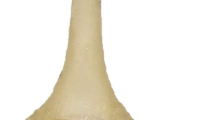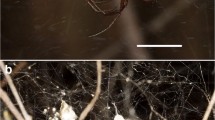Abstract
Since genital morphology can influence the outcome of post-copulatory sexual selection, differences in the genitalia of dominant and subordinate males could be a factor contributing to the fertilisation advantage of dominant males under sperm competition. Here we investigate for the first time if penile morphology differs according to male social status in a promiscuous mammal, the bank vole (Myodes glareolus). In this species, dominant males typically achieve higher reproductive success than subordinates in post-copulatory sexual selection, and male genital morphology is complex, including both a baculum (os penis) and penile spines. Our results show that despite no difference in body size associated with male social status, baculum width is significantly larger in dominant male bank voles than in subordinates. We also found evidence of positive allometry and a relatively high coefficient of phenotypic variation in the baculum width of male bank voles, consistent with an influence of sexual selection. By contrast, baculum length and three measures of penile spinosity did not differ according to male social status or show evidence of positive allometry. We conclude that dominant male bank voles may benefit from an enlarged baculum under sperm competition and/or cryptic female choice and that differences in penile morphology according to male social status might be important but as yet largely unexplored source of variation in male reproductive success.


Similar content being viewed by others
References
Andersson M (1994) Sexual selection. Princeton University Press, Princeton
Arata AA, Negus NC, Downs MS (1965) Histology, development, and individual variation of complex muroid bacula. Tulane Studies Zool 12:51–64
Artimo A (1964) The baculum as a criterion for distinguishing sexually mature and immature bank voles, Clethrionomys glareolus Schr. Ann Zool Fenn 1:1–6
Bonduriansky R (2007) Sexual selection and allometry: a critical reappraisal of the evidence and ideas. Evolution 61:838–849
Borkowska A (2010) Copulatory behaviour of the bank vole Myodes glareolus: matings with one and two males do not make a difference. Acta Theriol 55:343–349
Bretman A, Rodríguez-Munoz R, Tregenza T (2006) Male dominance determines female egg laying rate in crickets. Biol Lett 2:409–411
Burt W (1960) Bacula of North American mammals. Misc Pub Mus Zool U Michigan 113:1–75
Christiansen E, Wiger R, Eilertsen E (1978) Morphological variations in the preputial gland of wild bank voles, Clethrionomys glareolus. Holarct Ecol 1:321–325
Clarke JR, Clulow FV, Grieg F (1970) Ovulation in the bank vole, Clethrionomys glareolus. J Reprod Fertil 23:531
Clutton-Brock TH (2007) Sexual selection in males and females. Science 318:1882–1885
Cornwallis CK, Birkhead TR (2007) Changes in sperm quality and numbers in response to experimental manipulation of male social status and female attractiveness. Am Nat 170:758–770
Darwin C (1871) The descent of man and selection in relation to sex. John Murray, London
Didier R (1954) Etude systématique de l’os pénien des mammifères. Rongeurs. Famille des muridés. Mammalia 18:237–256
Dixson AF (1987) Observations on the evolution of the genitalia and copulatory behaviour in male primates. J Zool 213:423–443
Dixson AF (1995) Baculum length and copulatory behavior in carnivores and pinnipeds (Grand Order Ferae). J Zool 235:67–76
Dixson AF, Nyholt J, Anderson M (2004) A positive relationship between baculum length and prolonged intromission patterns in mammals. Act Zool Sin 50:490–503
Dunham AE, Rudolf VHM (2009) Evolution of sexual size monomorphism: the influence of passive mate guarding. J Evol Biol 22:1376–1386
Eberhard WG (1985) Sexual selection and animal genitalia. Harvard University Press, Cambridge
Eberhard WG (1996) Female control: sexual selection by cryptic female choice. Princeton University Press, Princeton
Eberhard WG (2009) Static allometry and animal genitalia. Evolution 63:48–66
Eberhard WG, Huber BA, Rodriguez RL, Briceno RD, Salas I, Rodriquez V (1998) One size fits all? Relationships between the size and degree of variation in genitalia and other body parts in twenty species of insects and spiders. Evolution 52:415–431
Eberhard WG, Rodriguez RL, Polihronakis M (2009) Pitfalls in understanding the functional significance of genital allometry. J Evol Biol 22:435–445
Friley CE (1947) Preparation and preservation of the baculum of mammals. J Mammal 28:395–397
Green AJ (1999) Allometry of genitalia in insects and spiders: one size does not fit all. Evolution 53:1621–1624
Harcourt AH, Gardiner J (1994) Sexual selection and genital anatomy of male primates. Proc R Soc B Biol Sci 255:47–53
Hooper ET, Hart BS (1962) A synopsis of recent North American microtine rodents. Misc Pub Mus Zool U Michigan 120:1–68
Horne TJ, Ylönen H (1996) Female bank voles (Clethrionomys glareolus) prefer dominant males; but what if there is no choice? Behav Ecol Sociobiol 38:401–405
Hosken DJ, Stockley P (2004) Sexual selection and genital evolution. Trends Ecol Evol 19:87–93
House CM, Simmons LW (2003) Genital morphology and fertilization success in the dung beetle Onthophagus taurus: an example of sexually selected male genitalia. Proc R Soc B: Biol Sci 270:447–455
Husak JF, Lappin AK, Van den Bussche RA (2009) The fitness advantage of a high-performance weapon. Biol J Linn Soc 96:840–845
Kinahan AA, Bennett NC, O'Riain MJ, Hart L, Bateman PW (2007) Size matters: genital allometry in an African mole-rat (Family: Bathyergidae). Evol Ecol 21:201–213
Klemme I, Eccard JA, Ylönen H (2006) Do female bank voles (Clethrionomys glareolus) mate multiply to improve on previous mates? Behav Ecol Sociobiol 60:415–421
Kodric-Brown A, Sibly RM, Brown JH (2006) The allometry of ornaments and weapons. Proc Natl Acad Sci USA 103:8733–8738
Kruczek M (1997) Male rank and female choice in the bank vole, Clethrionomys glareolus. Behav Process 40:171–176
Kruczek M, Styrna J (2009) Semen quantity and quality correlate with bank vole males’ social status. Behav Process 82:279–285
Kruczek M, Zatorska M (2008) Male ranks affects reproductive success and offspring performance in bank voles. Physiol Behav 94:611–615
Loyau A, Gomez D, Moureau B, Thery M, Hart NS, Saint Jalme M, Bennett ATD, Sorci G (2007) Iridescent structurally based coloration of eyespots correlates with mating success in the peacock. Behav Ecol 18:1123–1131
Lüpold S, McElligott AG, Hosken DJ (2004) Bat genitalia: allometry, variation and good genes. Biol J Linnean Soc 83:497–507
Miller EH (2010) Genitalic traits of mammals: systematics and variation. In: Leonard JL, Córdoba-Aguilar A (eds) The evolution of primary sexual characters in animals. Oxford University Press, New York
Miller EH, Burton LE (2001) It’s all relative: allometry and variation in the baculum (os penis) of the harp seal, Pagophilus groenlandicus (Carnivora: Phocidae). Biol J Linnean Soc 72:345–355
Miller EH, Nagorsen DW (2008) Bacular variation and allometry in the western marten Martes caurina. Acta Theriol 53:129–142
Milligan SR (1979) Copulatory pattern of the bank vole (Clethrionomys glareolus) and speculation on the role of penile spines. J Zool 188:279–283
Nakamura M (1998) Multiple mating and cooperative breeding in polygynandrous alpine accentors. II. Male mating tactics. Anim Behav 55:277–289
Parag A, Bennett NC, Faulkes CG, Bateman PW (2006) Penile morphology of African mole-rats: structural modification in relation to mode of ovulation and degree of sociality. J Zool 270:323–329
Parker GA (1970) Sperm competition and its evolutionary consequences in the insects. Biol Rev Camb Philos Soc 45:525–567
Patterson BD, Thaeler CS (1982) The mammalian baculum—hypotheses on the nature of bacular variability. J Mammal 63:1–15
Petrie M (1992) Are all secondary sexual display structures positively allometric and, if so, why? Anim Behav 43:173–175
Pomiankowski A, Møller AP (1995) A resolution of the lek paradox. Proc R Soc B Biol Sci 260:21–29
Ramm SA (2007) Sexual selection and genital evolution in mammals: a phylogenetic analysis of baculum length. Am Nat 169:360–369
Ramm SA, Khoo L, Stockley P (2010) Sexual selection and the rodent baculum: an intraspecific study in the house mouse (Mus musculus domesticus). Genetica 138:129–137
Ratkiewicz M, Borkowska A (2000) Multiple paternity in the bank vole (Clethrionomys glareolus): field and experimental data. Mamm Biol 65:6–14
Raveh S, Heg D, Dobson S, Coltman DW, Gorrell JC, Balmer A, Neuhaus P (2010) Mating order and reproductive success in male Columbian ground squirrels (Urocitellus columbianicus). Behav Ecol 21:537–547
Rozenfeld FM, Rasmont R (1991) Odor cue recognition by dominant male bank voles, Clethrionomys glareolus. Anim Behav 41:839–850
Rozenfeld FM, Leboulange E, Rasmont R (1987) Urine marking by male bank voles (Clethrionomys glareous Schreber 1780—Microtidae, Rodentia) in relation to their social rank. Can J Zool 65:2594–2601
Ryan JM (1991) Morphology of the glans penis in four genera of mollossid bats (Chiroptera: Mollossidae). J Mammal 72:658–668
Simmons LW, House CM, Hunt J, García-González F (2009) Evolutionary response to sexual selection in male genital morphology. Curr Biol 19:1442–1146
Sokal RR, Rholf FJ (1995) Biometry: the principles and practice of statistics in biological research, 3rd edn. Freeman, New York
Stockley P (2002) Sperm competition risk and male genital anatomy: comparative evidence for reduced duration of female sexual receptivity in primates with penile spines. Evol Ecol 16:123–137
Stoddart DM (1979) The copulatory pattern of the bank vole (Clethrionomys glareolus) and speculation on the role of penile spines. J Zool 188:279–300
Tasikas DE, Fairn ER, Laurence S, Schulte-Hostedde AI (2009) Baculum variation and allometry in the muskrat (Ondatra zibethicus): a case for sexual selection. Evol Ecol 23:223–232
Thomas ML, Simmons LW (2009) Male dominance influences pheromone expression, ejaculate quality, and fertilization success in the Australian field cricket, Teleogryllus oceanicus. Behav Ecol 20:1118–1124
Thornhill R (1983) Cryptic female choice and its applications in the scorpionfly Harpobittacus nigriceps. Am Nat 1222:765–788
Toner JP, Adler NT (1986) Influence of mating and vaginocervical stimulation on rat uterine activity. J Reprod Fertil 78:239–249
Acknowledgements
We are extremely grateful to Meg Stark and Peter O’Toole from York University for the scanning electron microscopy. We thank Prof. Jane Hurst and all members of the Mammalian Behaviour and Evolution Group for useful feedback and discussion and A. Davidson, J. Fick, R. Humphries, S. Jopson and J. Waters for help in conducting the experiment. We are grateful to three anonymous referees for their thoughtful comments. JFL and SAR were supported by a grant from the Leverhulme Trust to PS (F/00 025/W).
Author information
Authors and Affiliations
Corresponding author
Additional information
Communicated by A. Schulte-Hostedde
Rights and permissions
About this article
Cite this article
Lemaître, JF., Ramm, S.A., Jennings, N. et al. Genital morphology linked to social status in the bank vole (Myodes glareolus). Behav Ecol Sociobiol 66, 97–105 (2012). https://doi.org/10.1007/s00265-011-1257-4
Received:
Revised:
Accepted:
Published:
Issue Date:
DOI: https://doi.org/10.1007/s00265-011-1257-4




